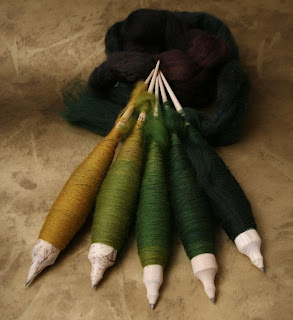So what is common between fiber gradient and polymer clay gradient? They are gradients and take work to build up.
Fiber gradient already colored, so I spin it.
Градиенты, градиенты. красиво, да. мне тоже нравится. Что общего между тем как сделать пряжу и полиглиной- так градент-же :). Пряжу я пряду, и градиент уже покрашеный, а что стоит сделать градиент из поли-глины. Прядем мы отсюда
to here
сюда
и сюда
and here
Now how the check do I build one of those ... clay, why not... it's th same principle as I would use to color the fiber (if I'd do that very nice Fiber Oprics Gradient, but I can buy it from that nice vendor and do not get into too big of coloring trouble), so... How much trouble is it to build a gradient out of clay... well about same as from fiber and same principle I'd use to mix the colors indeed.
so here we go. the clay (lots of work on the hands, no pasta machine was dedicated to it)
полиглина ввиде градиента в магазине не продается, ну может в спец магазине продается, и я б точно куила такое, потому как построить градиент на глине и на пряже чтоб красиво было это работы однако много. 2 часа, 3 цветочка. Однако меддленно, да. И я о том.
I had knives already :). just got 2 clay things to test and the kiddo picked the color.
Here is out basic color layout (revere triangle, cut on diagonal before that and cut in pieces, arrange by color)
Нодики уже имелись, раскладку делаем ту же что и для покраски градиентов. Ну тут смешивать придется, а там капли отмеряла и все.
and keep mixing, well fiber works a lot faster, clay... I'm slow, took me good 2h to get to the end of 3 flowers, and I'm sow with the flowers too, because I never have done it before
короче месим вот так, глина довольно жесткая по моим рукам. И через пару часов получаем 3 цветочка, по крайней мере похожи на простые цветочки.

mixing in pictures.


roll
месим, в ленту, сворачиваем, раскатываем.
repeat till you get it more or less even in color, make the set of even small logs
повторяем это пока не получим вот такие полоски градиента.

arrange them by color flatten with Chinese rolling pin, $3 at the store works good, fold or roll thatinto a log, make a longer log
после чего китайской скалкой за 3 доллара (по нашим магазинам это дешево) раскатываем, сворачиваем или скатываем в колбаску и раскатываем в колбаску опять
looks like a fiber already, make a ribbon out of that , fold the ribbon, make a log again (the color of the gradient will turn 90 degrees)
ну это уже похоже на покрашеную ровницу. это дело раскатываем в ленту и складываем, у нас градиент повернется на 90 градусов
and here we are
вот 3 цветоска

it's not perfect, but it looks like a flower
stash it till later, time's up :)
не идеально конечно, но похоже на цветочек, прикапываем на потом, потому как все, время кончилось :)































































